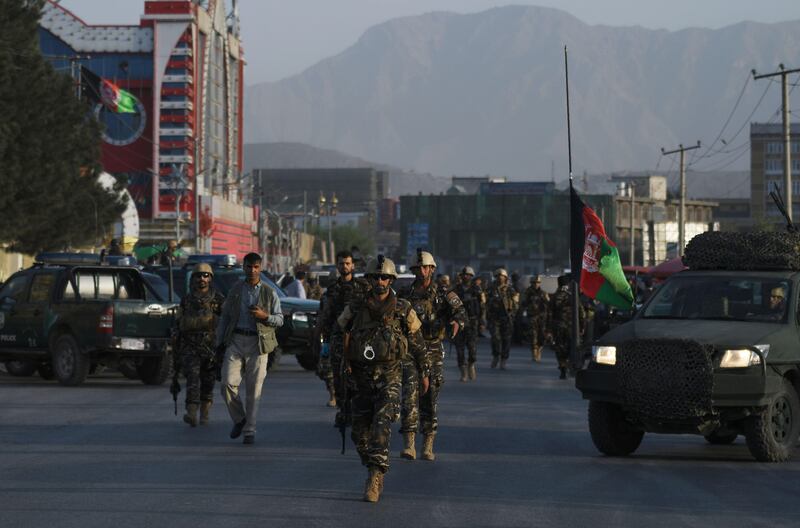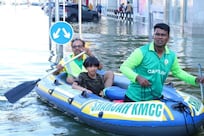Afghanistan is considering training and arming 20,000 civilians to defend areas where Islamic militants have been driven out, officials say, sparking fears the local forces could become another thuggish militia.
The proposal for a government-backed armed group that would protect its own communities from the Taliban and ISIL comes as Afghanistan's security forces, demoralised by killings and desertions, struggle to beat back a rampant insurgency.
But the proposal has raised concerns that the local forces could become unruly and turn into another abusive militia terrorising the people it is supposed to defend.
"The Afghan government's expansion of irregular forces could have enormously dangerous consequences for civilians," said Patricia Gossman, a senior researcher at Human Rights Watch.
The New York-based group said western diplomats in Kabul familiar with the plan — modelled on the Indian Territorial Army that supports the country's regular forces — said Afghan officials had expressed concerns the militia could be used by "powerful strongmen" or become "dependent on local patronage networks".
_______________
Read more:
[ Afghans bury Kabul mosque attack dead as toll rises to 28 ]
[ Nato applauds Trump's Afghanistan strategy ]
Comment: The dream of a secular Afghanistan still holds power - even over the White House
_______________
US and Afghan officials said the fighters would come under the command of the Afghan army and be better trained than the Afghan Local Police, a village-level force set up by the United States in 2010 which has been accused of human rights violations.
"Right now we rely on commandos and air strikes to retake the lost territories but after the commandos leave we don't have enough forces to hold onto the territories," said a senior defence ministry official.
"The force will operate under an army corps and will be used to fill the gaps. They will be recruited from the locals and will be numbered around 20,000."
Defence ministry spokesman Dawlat Waziri confirmed that a plan for "local forces" was being discussed.
"People will be recruited from their areas because they know their regions and how to keep them," Mr Waziri said, but added there was no guarantee it would be implemented.
A spokesman for Nato's Resolute Support train and assist mission also confirmed a proposal for an Afghan territorial army was on the table.
But another US official said the idea was still in "the brainstorming phase".
The Afghan government and its foreign backers have been cultivating militias to bolster the 330,000-strong Afghan National Security and Defence Forces as they battle to get the upper hand in the grinding conflict.
But militias — private armies and government-backed armed groups — have a long and chequered history in the war-torn country and many Afghans are wary of them.
Civilian casualties were at record highs in the first six months of 2017, a UN report showed, with forces loyal to the Afghan government accounting for nearly 20 per cent of the deaths and injuries.
Since Nato ended its combat mission in 2014, the Taliban have been gaining ground and ISIL is expanding its footprint.
As of February, only about 60 per cent of Afghanistan's 407 districts were reported to be under government control, according to the US watchdog agency Sigar.
Earlier this year, Afghan president Ashraf Ghani ordered a near doubling of the country's elite fighting force from 17,000 as part of a four-year road map that also aims to strengthen Afghanistan's air force.
Although US president Donald Trump's commitment to increase American troop numbers and leave them there indefinitely has been welcomed by Afghan authorities, they know it will take time to improve the fighting abilities of their security forces.
With parliamentary and presidential elections planned in the next two years they want a security quick fix.
But critics fear that rather than support Afghanistan's beleaguered security forces, a government-armed militia could aggravate factionalism and push Afghanistan deeper into conflict.
"It's a tool that the US military and successive Afghan governments have reached for and it looks like a solution to their problems but actually the real solution would be to have a functioning ANA (Afghan National Army) and ANP (Afghan National Police)," said Kate Clark, a senior analyst at the Afghanistan Analysts Network.
"It's a dangerous thing to play with, arming your civilians."
Meanwhile, Nato said on Saturday it would take a further month to respond to Washington's demands for alliance allies to send more troops to Afghanistan.
During a meeting of the Nato Military Committee in the Albanian capital of Tirana on Saturday, defence chiefs from 29 members of the organisation "recognised the need to fill the current … shortfalls" in troops, according to group president General Petr Pavel.
But no decision will be taken until they have consulted with their respective governments, Gen Pavel told reporters after Gen Joe Dunford, the US Chairman of the Joint Chiefs of Staff, and General John Nicholson, the top US commander in Afghanistan, presented their requests.
The meeting came after Pentagon chief Jim Mattis told Nato allies in June that they must finish the job in Afghanistan or risk allowing the insurgency to bloom.
Last month, Mr Trump cleared the way for the deployment of thousands more US troops to Afghanistan, backtracking from his promise to swiftly end America's longest war, which began after the terror attacks of September 11, 2001.
He did not specify how many soldiers would be sent but officials have said the additional troops could number some 4,000, on top of the 11,000-strong force already on the ground.





